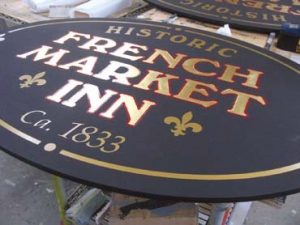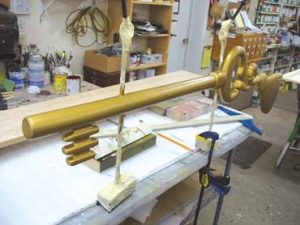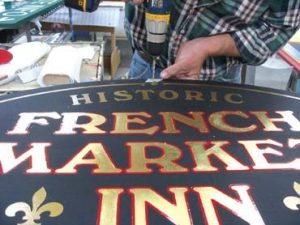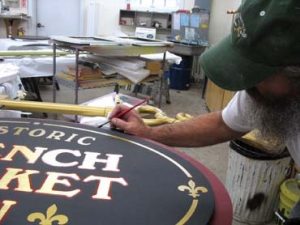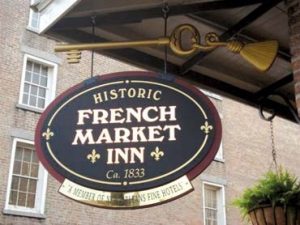Metal Fabrication
Something New for Old “N’Awlins”
Wood & Wood Signs beautifies a landmark that withstood Katrina.
Published
17 years agoon

My love for historic projects is well known — especially by my family members. So, I appreciated a phone call from my daughter, Charlotte, after she'd met Gary Cook, who worked at an historic inn. Charlotte was working as a glassblower in New Orleans, but she'd spent many hours working in our shop over the years and understood appropriate projects for Wood & Wood.
She also observed, although New Orleans is renowned for its history, not many of its signs have an historic flair. I called Cook, who worked for Patrick Wenn, the owner of 16 historic hotels. I sent Wenn and Cook photos of some of our historic projects. Coincidentally, we'd made plans to visit Charlotte in New Orleans the next month, so we set an appointment.
The historic French Market Inn is prominently located on the corner of Decatur and St. Louis streets, across from the Hard Rock Café. During my meeting with Cook, he noted this adorable old hotel was a landmark, but was difficult for guests to find. The existing signs were appropriately sized but lacked color contrast and the personality of this hotel, which was built in the 19th Century. Also, the existing signs didn't convey the high caliber of this hotel, which was a member of the Assn. of New Orleans Fine Hotels.
Additionally, I learned the fleur de lis, a distinctively French design, had become synonymous with New Orleans. So, before I left the city, I photographed numerous interpretations of that design, as well as the area's authentic architectural elements and colors. Before returning to Vermont, I measured the existing sign and photographed every necessary detail of the hotel's structure. Our initial meeting took place in November 2004, but Katrina's destructive swath last August obviously postponed our project.
A new look
Fast forward to 2006. When we resumed working on the project, Paul Perez was our new hotel contact. Perez, a longtime New Orleans resident and knowledgeable local historian, helped provide background information about the neighborhood.
Wood & Wood's sign-design process includes developing a Design Scope of Service, which outlines our design intent and calculates hourly costs. This document also offers a budget analysis for the sign's fabrication. Our proposal included the following provisions:
Advertisement• Developing upgraded, more visible designs for the two, double-faced signs under the building's canopy;
• Fabricating approximately 40 x 28-in. signs to comply with historic guidelines;
• Developing signage that reflects the building's quality and craftsmanship;
• Finding new typefaces, shapes and colors;
• Producing two or three designs that feature dark backgrounds and gilded copy with burgundy borders;
• A drawing that demonstrates how a metal bracket can improve the transition from the roofline to the top of the sign; and
Advertisement• Investigating lighting-design alternatives.
I believe a sign's design is the most important part of a client's investment, and most clients with historic projects strongly agree. Paul provided abundant feedback regarding design concepts, material suggestions, fabrication techniques and colors. He also added elements that dramatically impacted the design – a 3-D key and, at the sign's base, a brass plaque that bears the copy, "New Orleans Fine Hotels." Paul strongly believed the public needed to be aware of this distinction, which sets the French Market apart. Thus, we agreed with these design twists.
We began with the basics. The client wanted an oval sign, and I began rough sketching this to a 1 in. : 1 ft. scale. I conceived initial design sketches before passing them on to our computer draftspeople, who manipulated the rendering with Gerber Omega® and CADlink Technology Corp. SignLab® software. I typically draw front and side profiles to clarify our work.
Because the client indicated a possible name change in the next few years, I opted for a 1.5-in.-thick, laminated MDO motherboard slab with applied, -in., MDO signfaces on either side to simplify removal. I scratched out the copy position and size to fit the client's prescribed size limits. Because the sign hangs from a slightly pitched balcony roof, I designed custom, "U" brackets that could be bolted through the motherboard to join safely to the sign. I also devised a custom arm and bracket system with gooseneck lights that connects to the balcony ceiling.
After having reviewed my rough sketches, Paul decided we should light the sign from the building walls, which gave us a space to develop the key. I drew a rendition of the client's provided key graphic on the metal bracket that would attach to the ceiling. In addition, we added a brass plaque to the oval's bottom copy. Next, we decided to develop a black background with gilded copy, gold pinstripes and the ubiquitous fleur de lis. I also added red outlines around the goldleaf copy and burgundy border to the motherboard.
Fabrication keys
AdvertisementWith Paul's rough-sketch approvals, our lead computer draftsperson, George Dunne, began transferring the rough sketch to a scaled, computer rendering from which we could provide final pricing and fabrication details. We don't quote costs until final-drawing approval.
The brass plaque evoked past weathering issues we've experienced with brass. Product research unearthed Trumbull, CT-based US Sign & Fabrication's polished-gold titanium. The durable material arrived in such thin sheets that we mounted it to 1⁄8-in. PVC for added bulk. We opted for black, vinyl copy as a safe decoration method atop that finish. Our dilemma: how to design the key and custom-metal bracket combination required to make one rigid connection from sign to ceiling.
Dick Lane, Erik Joslin, George Dunne, Fred Spenser (our metal fabricator) and I decided to weld a metal template of an entire key to the vertical brackets, and then glue 1-in.-thick, Sign*Foam® high-density urethane panels on either side of the metal for us to carve its shape. The client provided only a small, rough graphic of a key with a tassel on its end. Because the actual key would measure 52 x 14 in., we had to be very accurate.
After an Internet search yielded an appropriate key design, developing the tassel and a suitable connection to the key proved challenging. I found a good photo of a tassel in a magazine, but it was challenging to carve one in a reasonable timeframe. We used a bandsaw, jigsaw, Dremel® tools and sandpaper to shape the key and tassel.
Daily photo submittals allowed the client to fine tune both the design and his budget quickly with us. We submitted drawings and actual-size paper layouts for their approval with the understanding that we would send progress photos as Erick and Dick carved and assembled the components.
We also sent our client progress photos that showed Donn Simpson painting the key and the signface. This progression from drawings to full-size paper layouts to shop photo holds no surprises for the client. The client was delighted when the sign arrived, and our team took great satisfaction knowing that we married diverse materials and three different design components into a sign for New Orleans' historic district. What fun!
Equipment and Materials
Goldleaf: Schwarbacher German 23k goldleaf, available from Art Essentials of New York (Tallman, NY), (800) 283-5323 or www.artessentialsofnewyork.com., and other art- or sign-supply stores.
Hardware/Tools: Custom-installed U brackets; hardware decking and SS washers, screws and powdercoated hanging apparatus; arcwelder, from industrial-equipment shops; carving gouges, chisels and rasps, from art- and woodworking-supply stores; and saws, drills and hammers.
Paint: Exterior-grade, latex paint, from Benjamin Moore Co. (Montvale, NJ), (866) 497-9513 or www.benjaminmoore.com; metallic enamels, from One Shot LLC (Gary, IN), (219) 949-1684 or www.1shot.com.
Plotter: envision® 750, from Gerber Scientific Products (South Windsor, CT), (800) 222-7446 or www.gspinc.com.
Substrates: Half- and 1.5-in.-thick MDO panels from New England Sign Supply (Woburn, MA), (800) 343-5870 or www.nesignsupply.com; 1-in.-thick Sign*Foam high-density urethane, from Sign Arts Products Corp. (Dana Point, CA), (800) 338-4030 or www.signfoam.com; coated gold titanium, from US Sign and Fabrication (Trumbull, CT), (203) 601-1000 or www.ussign.com.
SPONSORED VIDEO
Introducing the Sign Industry Podcast
The Sign Industry Podcast is a platform for every sign person out there — from the old-timers who bent neon and hand-lettered boats to those venturing into new technologies — we want to get their stories out for everyone to hear. Come join us and listen to stories, learn tricks or techniques, and get insights of what’s to come. We are the world’s second oldest profession. The folks who started the world’s oldest profession needed a sign.
You may like
Advertisement
Subscribe

Magazine
Get the most important news
and business ideas from Signsofthetimes Magazine.
Advertisement
Most Popular
-

 Tip Sheet2 days ago
Tip Sheet2 days agoAlways Brand Yourself and Wear Fewer Hats — Two of April’s Sign Tips
-

 Business Management1 week ago
Business Management1 week agoWhen Should Sign Companies Hire Salespeople or Fire Customers?
-

 Women in Signs1 week ago
Women in Signs1 week ago2024 Women in Signs Award Winners Excel in Diverse Roles
-

 Real Deal3 days ago
Real Deal3 days agoA Woman Sign Company Owner Confronts a Sexist Wholesaler
-

 Editor's Note1 week ago
Editor's Note1 week agoWhy We Still Need the Women in Signs Award
-

 Maggie Harlow2 weeks ago
Maggie Harlow2 weeks agoThe Surprising Value Complaints Bring to Your Sign Company
-

 Line Time1 week ago
Line Time1 week agoOne Less Thing to Do for Sign Customers
-

 Product Buying + Technology1 week ago
Product Buying + Technology1 week agoADA Signs and More Uses for Engraving Machines

